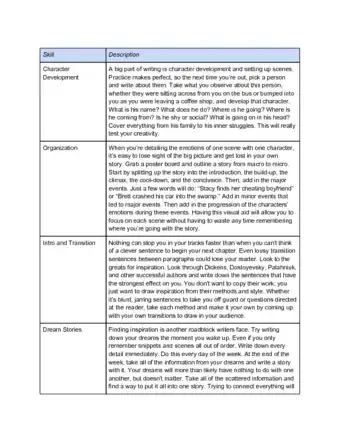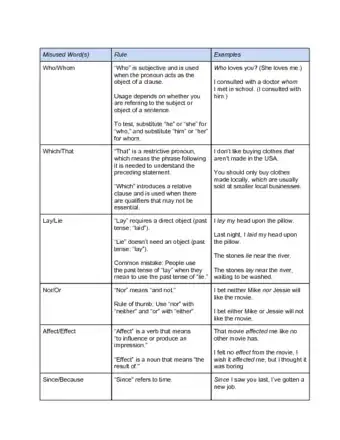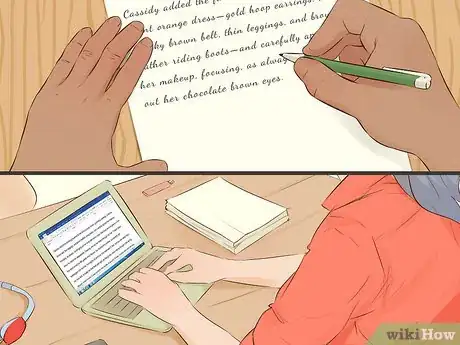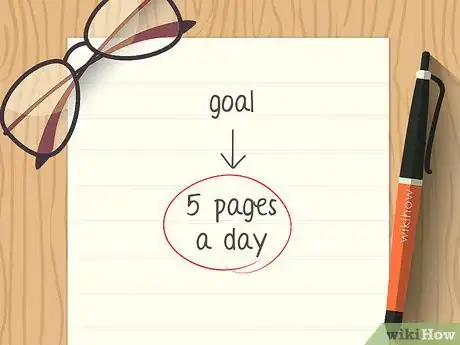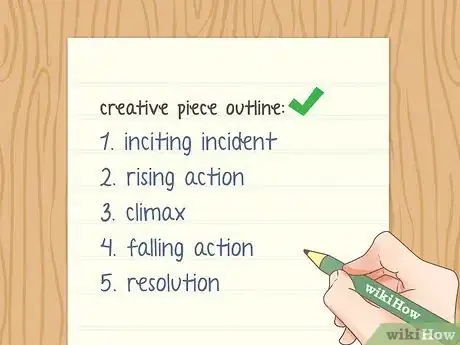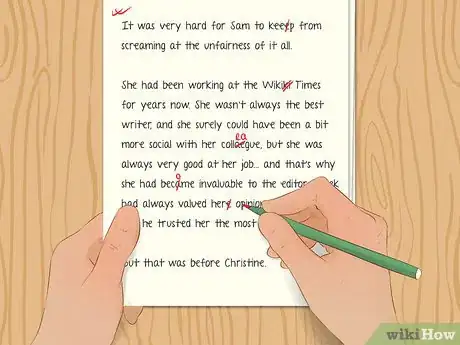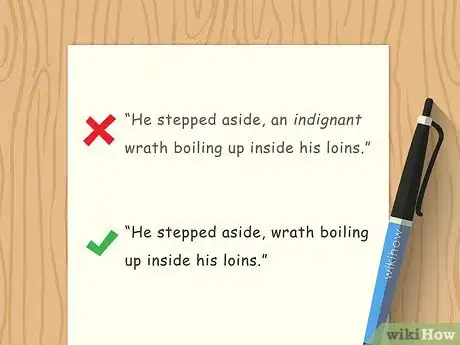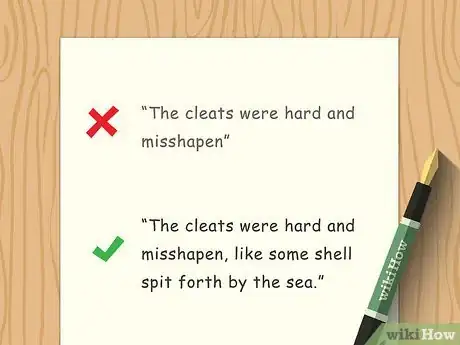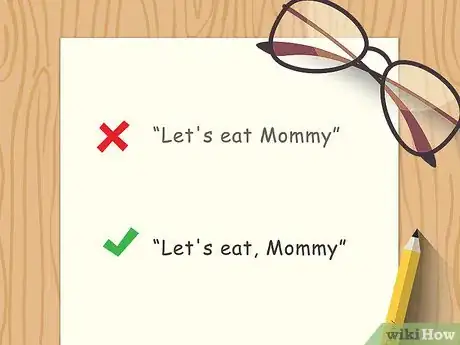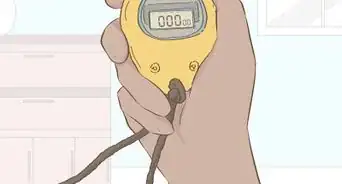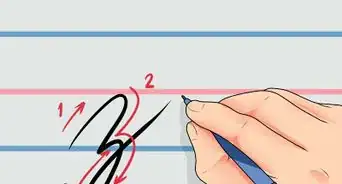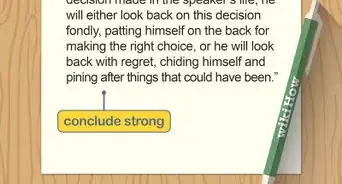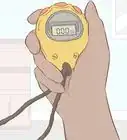This article was co-authored by Christopher Taylor, PhD. Christopher Taylor is an Adjunct Assistant Professor of English at Austin Community College in Texas. He received his PhD in English Literature and Medieval Studies from the University of Texas at Austin in 2014.
There are 19 references cited in this article, which can be found at the bottom of the page.
This article has been viewed 680,916 times.
Writing can be an amazing hobby and a necessary skill. From realistic fiction to mysteries to sci-fi to poetry to academic papers, your writing is only limited by your imagination. Keep in mind that writing is a lot more than putting pen to paper: it takes reading, research, thinking, and revising. While not all writing methods work for everyone, there are some things all writers can do to boost their craft and create a comprehensive, engaging piece.
Steps
Writing Help
Developing Your Writing Style
-
1Find your style. Before being able to develop your writing style, you must discover your writing style. A writing style is primarily made up of voice and tone. Whether you are writing a novel, article, or paragraph, your style is crucial.
- Your style can also vary on how long you have been writing and which genre you write in.
-
2Establish your reason for writing. Maybe you like writing as a hobby, or perhaps you want to publish a book. Maybe you have a long essay due for a class, or maybe you want to improve your copywriting skills at work. No matter what, you can always improve your writing. Understanding your writing goals simply makes it easier to know what to focus on moving forward.
- For example, if you’re writing a paper for a scientific journal, you won’t need to establish a setting as a novelist would. Understanding what you want to write helps you tailor your skill-building approach.
Advertisement -
3Read different authors, genres, and styles of writing. Read a wide breadth of authors, genres, and writing styles to expand your understanding of different styles and voices. Reading helps you develop what you want to write about and how you want your writing to sound.[1]
- Don’t limit yourself to one specific genre. Read novels, non-fiction books, fan fiction, poetry news articles, academic journal articles, and even good marketing material. Familiarizing yourself with as many writing styles as possible gives you a bigger toolbox.
- It's also a great idea to read texts that can help you accomplish the type of writing you want to do. If, for example, you’re writing a sci-fi novel, scientific journal articles will help you master the technical speech while good ad copy can teach you about sensationalism and emotional appeal.
- Keep up a regular reading schedule. Even if it's only 20 minutes a day before you go to sleep, you'll notice an improvement in your writing.
-
4Brainstorm topics, plots, and characters for a creative piece. Before you can start writing, you need an idea about which to write. You could write about zombie-mummy romances. You could write about Mercury. You could even write about yourself. There is nothing you can't write about. Consider these questions to help get you started:[2]
- What genre are you writing in?
- What themes do you want at the core of your story?
- What important traits will your main character have?
- What will motivate your antagonist?
- What tone (comedy, tragedy, etc.) will your story have?
- Why should the reader be interested in your plot?
-
5Map out subjects, topics, and arguments for non-creative pieces. Whether you’re writing a news article, a journal submission, a class essay, or a non-fiction book, start by narrowing down your topic. Think of as many related subjects, concepts, people, and data sets as you can, and use these to help narrow down your topic toward a subtopic of interest. You could create a mind map or rough sketch of the plot of the story. [3]
- Ask yourself questions like these: What is my argument? Who is my audience? What research will I need to do? What genre am I writing in?
- For example, if you need to write about the relationship between Greek and Phoenician gods, list out all the deities from each pantheon that you can think of along with their traits. Then, pick a few that have the clearest connection as support for your paper.
- If your subject is broader, like colonial overseas connections, you have more freedom. You can talk about how food crossed oceans or how people used to communicate between overseas colonies.
-
6Try freewriting to get your ideas flowing. Set a timer and write continuously until that time is up. You won't have time to worry about errors and mistakes if you're rushing to get the words out. It doesn't matter if you never use it, just beat the writer's block by filling the blank page and get your writer's muscles writing. Even nonsense is a start!
- Freewriting works for almost any style of writing. You can start writing a story, write down your thoughts and observations, crank out everything you know about your subject. Just let the words flow.
-
7Identify your audience and what they know about your subject. A good writer understands their audience’s perspective. They know how to use that to bring a reader into their piece. Think about who you intend to read your piece. The better you know your audience, the more you can cater your writing to the people who will actually read it.[4]
- Your audience will determine what language you use, what needs to be explained, and what can be assumed in your work.
- An academic audience, for example, likely already has a basic background in your field and prefers concise explanations over flowery prose. You don’t need to explain the basics to them.
- It’s natural to want your writing to appeal to everyone, but you’ll do better if you are realistic about your target audience. Someone who only reads romance novels may pick up your murder mystery, but fans of the genre are still your target group.
-
8Research your topic. No matter what you’re writing about, a little research goes a long way. For an essay, you’ll need to research data and sources specific to your topic. For a novel, look into technologies, histories, topics, time periods, people, places, and anything else that has real-world tie-ins to your writing.[5]
- Be selective about the information you retrieve online. Some Internet sources can be unreliable. Established sources such as peer-reviewed journals and books from academic publishing houses, have to undergo a thorough vetting process and are safer to use as sources.[6]
- Check out a library. You may be able to find information on your topic in a library that hasn't made its way to the web. For a greater breadth of resources, try a university library.
- Research is important for fiction pieces, too. You want your piece to sound plausible even if the events are made up. Details like saying your character is 600 years old and knew Caesar (who lived over 2,000 years ago) can take your reader out of your writing.
Crafting Your Piece
-
1Set up your timeline or goals. Your boss, teacher, or publisher may impose a deadline on you, or you may have to set one yourself. Use your deadline to set goals regarding what will be done by when. Budget time to write, revise, edit, get opinions, and incorporate feedback.[7]
- If you have an open deadline, you may aim for a goal like writing 5 pages a day or 5,000 words a day.
- If you have a specific deadline, like for a school essay, you may need to be more specific. For example, you may give yourself 3 weeks to research, a week to write, and a week to edit.
-
2Outline your piece. Crafting a simple outline helps you stay on track and make sure you hit all your most important points. Your outline can be a skeleton of your most basic points, or you can fill it in with more facts and information.
- Your outline should flow in the rough order that you want your piece. You can reorganize and rearrange as you write, but the point of the outline is to help your points flow together.
- Some writers prefer to work without an outline, and that’s totally fine. You should budget more time for revision and rewrites, though, since you don’t have a rough flow set before you start.
-
3Provide conflict, climax, and resolution in a creative piece. Creative writing can vary greatly, but the underlying story usually has a set-up, a conflict, a climax, and a resolution in that order. Give shape to your story by first introducing your protagonist and their world. Then, bring in a person, thing, or event that shakes up that world. Have that shakeup reach an intense or exciting peak (climax), before bringing everything to a close with a well-thought-out resolution.[8]
- Resolutions don't have to mean a happy ending if that's not your style. Your resolution should simply bring all the strands of your plot together so that they make sense.
- This form works for many types of creative writing, not just fiction. Popular history books often follow this format, for example.
-
4Give an analytical piece an introduction, evidence, analysis, and conclusion. Exactly how you organize an analytical piece depends on what your assignment and the standards for your field. At a minimum, though, analytical pieces generally introduce their topic and argument first, then move into supporting evidence, followed by the writer's analysis or interpretation, and then a conclusion.[9]
- If you conducted your own research or gathered your own data, your research methods should be discussed before you present your data.
- Discussion sections are also common in between the analysis and conclusion. These talk about other possible interpretations of your data and what work should follow to answer questions brought up by your research.
-
5Write your first draft. Write down anything and everything you may want included in your writing. It doesn't matter how many spelling errors or weak adjectives you have in it. You’ll have time to reorganize your piece and edit later, so focus building out all your ideas in the beginning.[10]
- You can draft a full version of your piece, or you can draft in stages. Stages, like going chapter-by-chapter, can be particularly helpful if you’re writing a longer piece.
- If you have an outline, don’t worry about following it to the letter. Your outline helps instruct the general flow of your piece. It’s a guide, not a rule book.
-
6Edit in your second draft. Review your first draft and begin to edit and reorganize your content. Flesh out the plot or your argument and focus on creating clean transitions from one point to the next. Start thinking about what doesn’t work and may need to be cut, too.[11]
- Check for coherency. Do all parts of your piece make sense together? If so, continue. If not, consider revising or cutting whatever doesn't fit in.
- Check for necessity. Do all parts of the story contribute? Does each section give necessary background, advance your plot or argument, develop an important character or point, or introduce critical analyses? If not, cut it.
- Check for anything missing. Are all your characters or points properly introduced? Is all your supporting data or information present? Do your points flow smoothly together, or are there some logical gaps?
-
7Rewrite until you're ready to get an outside opinion. Writing often goes through many drafts and stages. Keep rewriting, reorganizing, and revising your content until you’re comfortable showing it to someone else to critique. Keep your deadline in mind, and make sure you have enough time to edit before you submit your final piece.[12]
- There is no set number of drafts you do before a piece is done. The exact number of drafts you go through will depend on your timeline, your comfort level, and your personal writing style.
- It’s common to feel like there’s always something more to add or revise, but try not to focus on perfection. At some point, you will need to put your pen down.
Cleaning up Your Writing
-
1Proofread your piece for technical errors. Remember that spell check alone doesn't always do the job. Only you can catch the difference between to, too, and two, or their, there, and they're. In addition to looking for misspellings and grammatical errors, check for items like overused words and improper word use.[13]
- Online tools like Grammarly and the Hemingway editor can help check for more advanced issues like clarity and word use. Just like spell check, though, you shouldn’t depend on these for full edits.
-
2Ask for outside opinions. This is an important step, as other people will see what you actually wrote, and not just what you think you wrote. Ask at least 2-3 people you trust to review your work and look for things like clarity, consistency, and proper grammar and spelling.[14]
- Teachers, professors, topic experts, your colleagues, and other writers are all good people to ask. You can also join a writer’s group to share your work, read others' writing, and give mutual feedback.
- Ask them to be honest and thorough. Only honest feedback, even if it's a wholesale criticism of your entire story, can make you a better writer.
- If they need some guidance, give them the same questions you've been asking yourself.
-
3Incorporate the feedback you received from others. You don't have to like or agree with everything someone says about your work. On the other hand, if you get the same comment from multiple people, you should take it seriously. Strike a balance between keeping aspects that you want and making changes based on input you trust.[15]
- Re-read your work with your readers' comments in mind. Note any gaps, places that need to be cut, or areas needing revision.
- Rewrite necessary parts using the insights gained from your readers and from your own subsequent critical reading.
-
4Omit needless words. If a word isn't essential to the telling of the story or the semantics of the sentence, omit it. It's better to have too few words than too many. Too many words makes your writing sound stuffy, pompous, or unreadable. Be especially careful of:
- Adjectives. Adjectives describe nouns and are most effective when they’re used intentionally and selectively. Take the sentence: "He stepped aside, an indignant wrath boiling up inside his loins." "Indignant" means angry, but so does "wrath." A better sentence would be: "He stepped aside, wrath boiling up inside his loins."
- Idioms and slang. Idioms, such as "a piece of cake" or "foam at the mouth," don't always translate into enjoyable writing. Like slang, they date the piece (who says "suck the milk of nations" anymore?) and can be misinterpreted.
- Be verbs. Change be verbs, such as is, was, are, were, am, and being, to active verbs. For example, don't write, "She was tired." Instead, say, "She collapsed under the weight of exhaustion."
- Strings of prepositional phrases. It's okay to use prepositional phrases, but don't list several in a row. For example, don't say, "The cyborg climbed on the molding above the staircase along the wall beside the throne." Instead, you could write, "The cyborg skirted the staircase molding on the wall closest to the throne."[16]
-
5Keep your vocabulary simple. While lengthy and flowing prose have their place, often clear and simple is the best technique. Avoid using jargon or big words just to sound professional or authoritative. Often, that has the opposite effect. Overly complicated writing can also confuse your audience. Take a look at these examples from Hemingway and Faulkner. Which is easier to follow?[17]
- "Manuel drank his brandy. He felt sleepy himself. It was too hot to go out into the town. Besides, there was nothing to do. He wanted to see Zurito. He would go to sleep while he waited " — Ernest Hemingway, Men Without Women.
- "He did not feel weak, he was merely luxuriating in that supremely gutful lassitude of convalescence in which time, hurry, doing, did not exist, the accumulating seconds and minutes and hours to which it its well state the body is slave both waking and sleeping, now reversed and time now the lip-server and mendicant to the body's pleasure instead of the body thrall to time's headlong course. " — William Faulkner, The Hamlet.
-
6Use verbs to move your sentence. A well-placed verb will make a sentence dazzle and keep it free from excessive adjectives. Build your sentence using strong verbs whenever possible.[18]
- Take the following sentence: "He creepily went into the room." There's nothing wrong with this sentence, but it's a little bland and wordy. You can enhance the sentence and be more specific by introducing a new verb. Try "crept," "slunk," or "slithered" in place of “creepily went.”
-
7Pay attention to verb voice. In a sentence written with active voice, the subject performs the action (e.g. "The dog found its master"). In passive voice, the subject receives the action (e.g. "The master is found by his dog"). Use active voice whenever possible as a rule of thumb.[19]
- In some fields and industries, passive voice is standard. For example, as science paper may say “The solution received 2 drops of the activator,” to keep the subject out of the sentence. If passive voice is standard in your field, follow those conventions.
-
8Use figurative language for effect in creative pieces. Figurative language includes devices like simile, metaphor, personification, hyperbole, allusion, and idiom. Use figurative language sparingly for effect. "The cleats were hard and misshapen" might be more vivid using a simile: "The cleats were hard and misshapen, like a shell spit out by the sea."[20]
- It’s easy to stick to similes and metaphors, but try adding different devices to give your writing depth and texture. Hyperbole, for instance, can make your writing explode off the page.
- Another example of figurative language is personification, which lends human attributes to non-human things. "The wind danced across the sky," creates the image of strong but graceful wind without having to say, "The wind was strong but graceful."
-
9Choose your punctuation carefully. Punctuation helps us understand what different word arrangements mean. Punctuation should be present and fluid but not attention-grabbing. People make the mistake of trying to get punctuation to do too much, be flashy, or call attention to itself. Focus on how your punctuation impacts the flow of your writing, not on using as many commas as you can.[21]
- Use exclamation points sparingly. People don't often exclaim things; nor do sentences often merit exclamation. "Jamie was excited to see him!" for example, does not need an exclamation point. The sentence already states that Jamie is excited.
Community Q&A
-
QuestionHow do I get inspiration for my writing?
 Community AnswerMaybe try to listen to some music that suits the scene you want to write (for example some love ballad for romance scenes or hard rock for fight scenes) and listen to the song's lyrics. Reading books or short stories about the setting might help, too. You have to try out different things, but there's always loads of options. Use the world around you to inspire you.
Community AnswerMaybe try to listen to some music that suits the scene you want to write (for example some love ballad for romance scenes or hard rock for fight scenes) and listen to the song's lyrics. Reading books or short stories about the setting might help, too. You have to try out different things, but there's always loads of options. Use the world around you to inspire you. -
QuestionI try to use metaphors and similes; however, sometimes the writing looks very stuffed and deliberate. How to avoid this effect?
 Community AnswerKeep writing. This will improve with practice and a reflective, self-critical eye. Try not to self-edit too much as you compose, as this can stifle your creativity and keep you from generating material. Afterwards, review your writing. Delete any flowery or excessive figurative language, trying to keep similes and metaphors to a bare minimum. Work on including strong, precise verbs and specific nouns to give your text a cleaner, lighter feel and look.
Community AnswerKeep writing. This will improve with practice and a reflective, self-critical eye. Try not to self-edit too much as you compose, as this can stifle your creativity and keep you from generating material. Afterwards, review your writing. Delete any flowery or excessive figurative language, trying to keep similes and metaphors to a bare minimum. Work on including strong, precise verbs and specific nouns to give your text a cleaner, lighter feel and look. -
QuestionHow do I write about emotions?
 CeheaCommunity AnswerTry to use a range of adjectives, but not too many. If you were describing anger, you could put something like, "I clenched my fists, scowling. 'How could she!' I shouted furiously before kicking a wall." This is more effective than, "I was angry because of what she did and I kicked a wall."
CeheaCommunity AnswerTry to use a range of adjectives, but not too many. If you were describing anger, you could put something like, "I clenched my fists, scowling. 'How could she!' I shouted furiously before kicking a wall." This is more effective than, "I was angry because of what she did and I kicked a wall."
References
- ↑ https://www.bostonglobe.com/lifestyle/2016/05/30/want-write-better-read-more/pxGs6c2hhhJpfdcVWbbz1H/story.html
- ↑ http://www.writersdigest.com/editor-blogs/there-are-no-rules/how-to-brainstorm-give-your-brain-free-rein
- ↑ https://writingcenter.unc.edu/tips-and-tools/brainstorming/
- ↑ https://www.plainlanguage.gov/guidelines/audience/
- ↑ http://www.writersdigest.com/editor-blogs/guide-to-literary-agents/how-to-research-a-novel-7-tips
- ↑ https://www.press.uchicago.edu/books/turabian/tcc/topicsheet10.pdf
- ↑ https://writershelpingwriters.net/2017/04/the-efficient-writer-using-timelines-to-organize-story-details/
- ↑ https://www.writersdigest.com/writing-articles/by-writing-goal/write-first-chapter-get-started/4-story-structures-that-dominate-novels
- ↑ http://advice.writing.utoronto.ca/planning/organizing/
- ↑ http://www.writersdigest.com/editor-blogs/there-are-no-rules/fruitless-first-draft-struggles
- ↑ http://www.library.dmu.ac.uk/Support/Heat/index.php?page=492
- ↑ http://www.library.dmu.ac.uk/Support/Heat/index.php?page=492
- ↑ https://writingcenter.unc.edu/tips-and-tools/editing-and-proofreading/
- ↑ https://grad.arizona.edu/ofce/articles/2016/08/five-tips-getting-helpful-feedback-your-writing
- ↑ https://grad.arizona.edu/ofce/articles/2016/08/five-tips-getting-helpful-feedback-your-writing
- ↑ http://www.fsb.miamioh.edu/fsb/content/programs/howe-writing-initiative/HWI-handout-editingforconcision.html
- ↑ https://learning.blogs.nytimes.com/2012/09/20/writing-rules-advice-from-the-new-york-times-on-writing-well/
- ↑ http://www.owlnet.rice.edu/~cainproj/writingtips/preciseverbs.html
- ↑ https://writing.wisc.edu/Handbook/CCS_activevoice.html
- ↑ https://online.maryville.edu/online-bachelors-degrees/online-literary-devices-guide/
- ↑ http://www.thepunctuationguide.com/top-ten.html
About This Article
Before you start writing something, regardless of whether it’s creative or academic, do some research on your subject so you have a better sense of how to begin. If you’re already comfortable with the subject matter, you can also try free-writing for 10 minutes. Try not to worry if your free writing is “good” writing, and instead just focus on getting your creativity flowing!
Then, once you’re ready to write, draft a quick outline for your piece. If you’re writing an academic essay, write down your thesis, which is your central argument. Flesh out your academic outline by writing down the arguments and examples you’ll use to support your argument, and what conclusion you’re drawing with those examples. Alternatively, if you’re writing something creative, write down your inciting incident, which is what starts the action. Follow that with a couple of ideas for your rising action, which should lead to your climax. The climax is the turning point in your story, which is when your main character will overcome the conflict. Then, outline your resolution, which is how your story will end. Keep in mind that your resolution doesn’t have to be happy as long as it leaves the readers feeling satisfied with your plot.
Once you’ve written your first draft, take a break from your work if you can, so you can come back to it with fresh eyes. First, read your writing once without a pen so you can see if you like the overall structure. If you don’t, try rewriting! However, if you’re happy with the way it’s turned out, edit your piece for grammar, clarity, and sentence structure. Finally, ask someone you trust to read it and give you feedback. For more tips from our Academic co-author, including how to develop a unique writing voice, read on!
